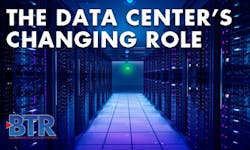There are several dynamics driving the sector. On the highest level, the amount of data that must be trafficked and stored is exploding. Every news story about the growth of mobile data, the development of a new delivery platform, more targeted ways of reaching customers and other advances have one thing in common: Data centers will be called upon to do more.
At the same time, virtualization has revolutionized the way in which data centers operate. The ability to subdivide equipment and bring resources to bear that otherwise would be wasted has ushered in a revolution in efficiency. Combined with software-defined networks and network functions virtualization (SDN and NFV) - ambitious new architectural approaches - the issue of geography has been made much less of a limiting factor in determining use of data center and related capacity.
The third fundamental change in data center operations has been the drive to radically curtail the amount of energy they use per bit of data. Data centers use enormous amounts of energy. Cutting use saves money - lots of money - and is the environmentally conscious thing to do. Indeed, the biggest of the data center users - such as Google, Amazon Web Services, Facebook and Microsoft - all have announced ambitious renewable energy plans. The goal for all of these companies is to use 100% renewable energy - and sooner rather than later.
So, where do cable operators fit into all these changes in data centers? To put it simply, squarely in the middle. They face the same challenges as the other big players. Experts point out that there is a fundamental difference between cable companies and telcos on one side and the likes of AWS, Google and the others on the other: Facilities-based providers have deep local presences and responsibilities. Though it is not common to think of hubs and headends as “data centers,” they use much of the same equipment and fulfill many of the same tasks.
Thus, the cable industry’s data center concerns are divided between what is happening on the local level and what is happening at the regional and national levels. The SCTE’s Energy 2020 initiative is aimed at increasing efficiency on both levels.
At the national level, a driver of change is that the cable industry no longer is a parochial business. Operators must support TV Everywhere and other services that are not bound by geography. Offering a subscriber who lives in New York City, for instance, access to her personalized subscription while she is vacationing in Los Angeles has significant data center ramifications. The need to send video, WiFi, voice and other types of traffic broadly is driving the creation of huge data centers.
The data centers provide both storage and connectivity. “[Cable has] always operated in geographic pockets and stayed in its own sandboxes,” said John Romagnoli, the director of communication products for Atlantic Broadband. “As the cable industry moves deeper into the data center world, now we can become partners. If a cable provider has a customer in another cable company’s back yard, being in a data center lets us create network-to-network connectivity.”
While data centers are anchoring the increased national scope of the industry, more subtle but related shifts are occurring on the local level. One of the biggest challenges facing operators during the past decade is finding the space and energy to drive headends and hubs as a list of new services, from voice to IP video to WiFi, are added. One answer is the advent of the Converged Cable Access Platform (CCAP), which consolidates a lot of formerly discrete functions.
Virtualization is a help here as well. The ability to accommodate multiple “devices” on the same hardware and to decide more freely where tasks are performed gives operators far more freedom than in the past. Operators are freer to choose where to do things, said Chuck Carroll, the director of technology and strategy for Coppervale Enterprises. Availability of space and power can be one of the determining factors.
Experts say another driver of cable’s interest in quickly evolving their data centers simply is that they can be revenue generator. Data center capacity can be a valuable selling point as the industry expands the commercial services side of its business. The ever-growing importance of data center capabilities to cable operators was illustrated by a deal announced earlier this month between Atlantic Broadband and Miami Data Vault. The companies say the deal will provide MDV customer access to business services offered by Atlantic Broadband.
The power issue is a very important. The national data centers are moving in the same direction as the higher profile AWS and Google facilities. Things are a bit different on the local level, however. Local facilities by and large are legacy buildings that weren’t architected and built with energy efficiency in mind. A second element differentiating the national from the local data centers simply is geography. A cable operator serving subscribers in Phoenix needs to have hubs and headends in Phoenix - and it needs to cool them.
While it is clear that the local facilities will never quite match the huge centralized facilities, they will improve their efficiency by using many of the same approaches. “The edge facilities are going to be treated more like data centers from the energy efficiency standpoint,” said Daniel Howard, the SCTE’s senior vice president of engineering and CTO.
The goal is to not to let energy issues become an inhibitor. The issue at hand - and the challenge - is clear: “How do we make energy efficient and continue to improve on that over time so that we ensure that energy is not an issue in how we develop the business?” Carroll said.





